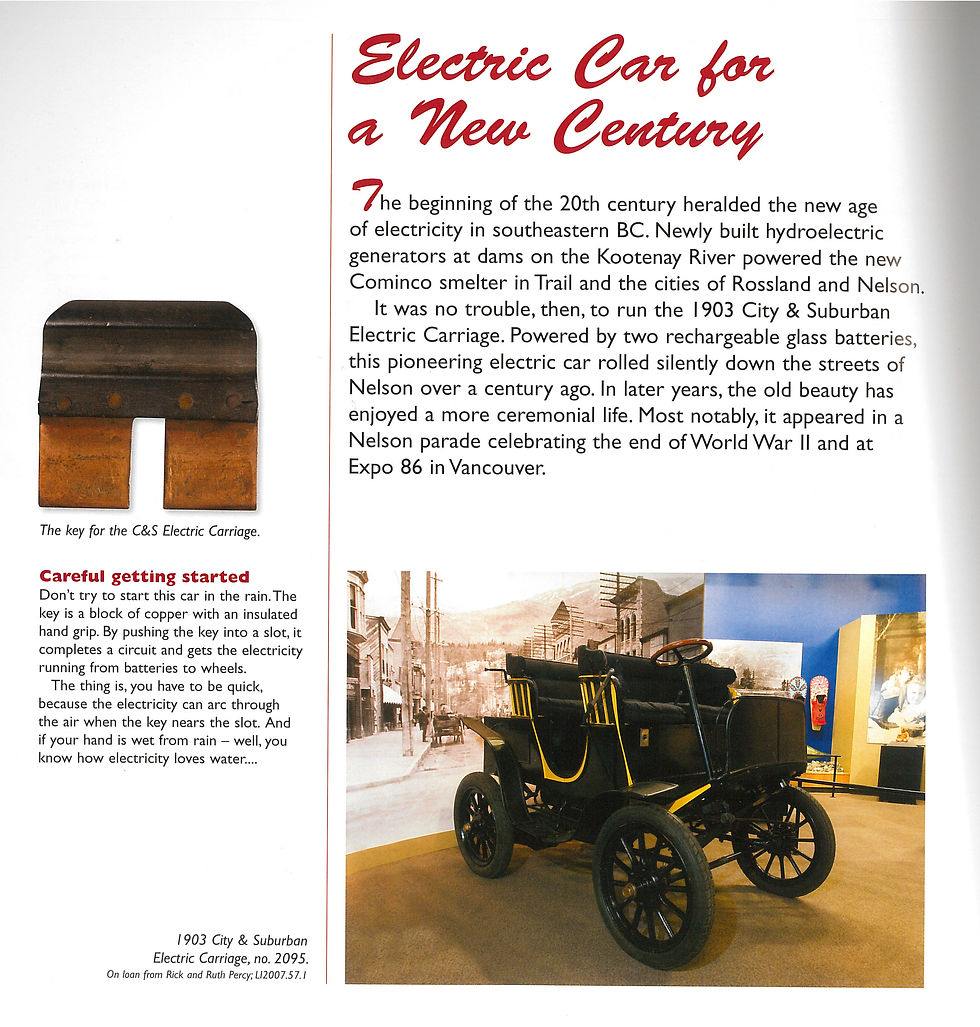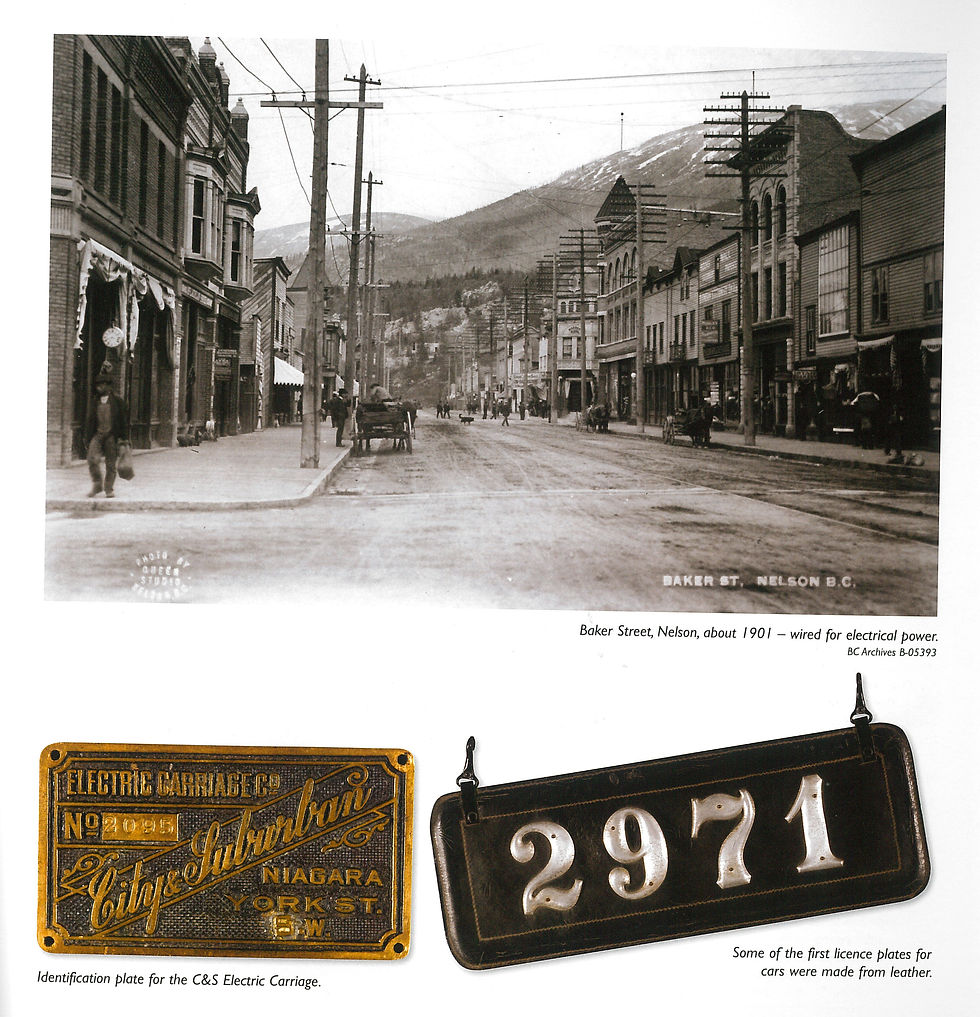Electric cars of Kootenay/Boundary: An electric car fit for a king?
- Greg Nesteroff

- Apr 29, 2018
- 8 min read
Updated: Aug 16
Third in a series on local electric cars
The most noteworthy early electric vehicle in our area belonged to a Kootenay lumber baron, the appropriately-named Alfred Edward (Ted) Watts (1856-1937). Known as a special touring phaeton, it was manufactured in London in 1903 by the City and Suburban Electric Carriage Co., based on the Columbia design by the Electric Vehicle Co. of Hartford. It cost £700 new, which is something like $34,000 Cdn today.

Ad from an unknown publication. (Courtesy bruceduffie.com/thecolumbia.html)
The text that accompanied the above ad laid out the particulars: It had a maximum speed of 26 miles per hour, an average speed of 13 miles per hour, and could seat four. The upholstery was in leather, corduroy or “best rep.” It had silver-plated mountings and you could pick your colour. It had specially-made pneumatic tires and came with electric carriage lamps and gong. The ad went on:
This Special Surrey Phaeton has been constructed to meet the requirements of gentlemen who desire the advantage of an Electric Carriage in combination with the power to run long distances on one charge of current. This Carriage is fitted with a 300 ampere 96-cell battery which gives a distance of 100 miles at 13 miles per hour, or 70 miles at 26 miles per hour, on one charge of current. These distances are calculated on level, hard, dry roads.
Watts acquired one of these carriages in 1909 to augment a Rambler he purchased earlier that year from Nils Hanson. He drove it the 12 miles between his namesake town of Wattsburg (later renamed Lumberton) and Cranbrook. He did not hold a BC license for it, at least through the end of 1912.
“Grandfather always bought the newest thing on the market,” recalls Watts’ grandson Bob Oliver, who provided the portrait seen here.

Around 1918, Watts started a fox farm at South Slocan and moved the carriage there, where it sat unused in an outbuilding. Oliver says as a child “we didn’t pay much attention to it.” It remained untouched until 1947 when Nelson Transfer asked if they could drive it in the city’s jubilee parade. It was still in reasonably good shape although it no longer ran.
“I forget how many batteries it took to get it going,” Oliver says. “They went down that steep hill on Baker Street.”
It’s not clear how Nelson Transfer knew about the carriage or what kind of range the vehicle had once it was back in motion. But wheel aligner John DeGirolamo, also known as John De, helped get it started again. He had the honour of driving the carriage in the parade with wife Gina and children Geri and Norm, all wearing period costumes. A few photos exist, seen below.


The DeGirolamo family is seen in the Watts electric carriage in 1947. The bottom photo was taken in the 300 block of Baker Street. The Masonic Lodge is seen at right. (Touchstones Nelson: Museum of Art and History 2003.032.25 [top] and 1987.120.065 [bottom])
There is also a brief bit of surviving footage of the car in the parade, taken by George Craft. The copy I have is converted from an old VHS tape that has unfortunately lost its colour, but it is seen below on a loop.

The Nelson Daily News of Aug. 5, 1947, in reporting on the parade, mentioned a 1910 auto from Creston and then added:
Even of later [sic] model was the 1903 relic driven by John DeGirolamo of Nelson. The ancient car ran without the usual roar and while it did not smack of excess speed Mr. DeGirolamo had a pair of goggles over his eyes just in case. He won first prize in the decorated automobile section …
John DeGirolamo died in Nelson in 2007 at 92 and his wife Jeana passed in 2011 at 94.
After the parade, the carriage returned to the shed in South Slocan (presumably not under its own power). I was surprised to discover that it came back out a decade later for another parade in Nelson. The museum has placed a few videos of the parade on its YouTube channel. In the first one, the car goes by at the 1:50 mark. In the second one, it is seen at the 7:28 mark.
Afterward, the family tried to dispose of the car.
“We had a hell of a time trying to sell it,” the late Bob Oliver told me. “My mother got in touch with different old car aficionados in the States. They weren’t interested. So it just sat here until finally my brother-in-law Roy Mills asked if he could buy it. She said certainly. He didn’t pay much and she didn’t want much.”
Mills moved it to his home in Slocan City, where Eric Winje remembers sitting in it as a teenager. He says the shed where it was kept still stands on the north side of Delaney Avenue.
In 1965, Mills sold the carriage to Lower Mainland antique car enthusiast Rick Percy, who discussed seeing it for the first time in a 2016 Vancouver Sun story. “I went in and looked at it and it was like a football hit me in the head,” Percy recalled. “Each hubcap had the date punched in it, so there was no fooling — it said 1903.”
Although the car’s wooden wheels were intact, its batteries and brass lights had been removed.
Percy exhibited the car often, including at Expo ’86, although he couldn’t find a battery to make it run. He died before I had a chance to speak to him and clarify some discrepancies; he said it was drawn in parades by horse and had been brought from England by a West Kootenay Power executive. (The latter point would no doubt have enraged Watts — nicknamed Terrible Tempered Watts — for at one point he sued the company in a dispute over power to his farm.)
In 2014, Percy sold the carriage to Edward Salvail of Maple Ridge, who is bringing it back to life. This is what it looked like when Salvail acquired it:

Here’s the wild part: City and Surburban was famous for making a 1901 motor carriage for Queen Alexandra, wife of King Edward VII. When Watts acquired his car, the Cranbrook Prospector of Aug. 7, 1909 reported: “A.E. Watts of Wattsburg has purchased a new electric automobile, which arrived at Cranbrook last week. The auto is one of the nicest in the district, and was formerly owned by the Prince of Wales.”
At first blush, that just sounds like something the salesman invented. But the prince (the future King George V) did own two City and Suburban electric cars: a brougham, custom-made in 1903 for city use, and a motor-phaeton, acquired in 1902 or earlier for country rides. The latter is the one we are interested in, although the date of manufacture suggests it is not the same one seen above, which is a 1903 model.
Nearly all we know about the prince’s phaeton is what appeared in a publication called The Sketch, on Dec. 3, 1902:
The new motor-phaeton belonging to the Prince of Wales shows an advance toward the enlargement of the capacities of electrically propelled carriages. This new design, constructed by the City and Suburban Electric Carriage Company, who also supplied the electrical voiturette used by the Queen, has a capacity for traveling 90 miles on one charge of the storage battery, when conditions are not unduly adverse, and it can attain a speed of twice the legal limit. Heavy roads and hills eat up current gluttonously on electrical vehicles, but it is interesting to find them progressing from their earliest and most appropriate use as town carriages into adaptability for prolonged country journeys. Seers of the sanguine sort foretell the universal use of electricity as the propelling agent of motor-cars ere long, but at the moment their limitations for fresh supply of current handicap them compared with the practically inexhaustible petrol-engine, which, when its supply does need renewal, can be satisfied in fewer minutes than the electrical vehicle demands hours.
(The prince’s father, who became Edward VII, also had a phaeton in 1900, but I don't know who built it.)
I asked Peter Pigott, author of Royal Transport: An Inside Look at the History of Royal Travel, about the brougham (at the time I didn’t know about the phaeton). He researched his book at the Royal Archives at Windsor Castle and replied: “There was no evidence there to even hint that the car in question was ever sold, let alone sent outside England.”
So did it end up in a Royal scrapyard? “If I learnt something from the Royals, it’s that nothing is ever thrown out. If anywhere, it would be in the Royal Motor Museum at Sandringham.” (I checked — they don’t have it.)
It would be easy to conclude that Watts was fed a line of nonsense when he bought the carriage or was told “It’s just like the prince’s!” and misunderstood that it was the prince’s.
While Bob Oliver didn’t recall his grandfather discussing it, he had a vague memory of his mother mentioning the carriage’s royal provenance — so Watts may have honestly believed it once belonged to the prince. While a few other contemporary newspaper references to Watts’ previous vehicle exist, there’s only the single mention of this one. Frustratingly, the Cranbrook paper failed to elaborate on a statement that should have been as astonishing then as it is now. Pity that Ted Watts didn’t keep the original bills of sale and lading.

Ed Salvail thinks it’s more likely the carriage was once part of a fleet of taxis operated by the Carlton Hotel in London. The item at right reveals they were painted black and pale yellow, already a common colour scheme for cabs. The Watts car is black and yellow.
“While rebuilding this carriage I noticed several [other] things that might be clues to its history,” Salvail says.
“1. There are remnants of a bracket that held a wheel odometer.
“2. The wiring was altered en masse; lots of splices that would not have been done at a factory level.
“3. Some attachment studs (bolts) are not holding anything.
“Was this refitted? If only it could speak … I still like the notion the carriage was a taxi and possibly nobility was transported in it.”
Salvail says he has spent many hours researching the vehicle and is slowly assembling a manual that will follow it to future owners. “It will include all history, repairs and collaborations that have taken place. I take it as an honour and my duty to preserve this carriage. I await the day I can drive it down the road.”
You can read more about some of the carriage’s intriguing mechanisms here.
Bruce Duffie has put together an amazing site on the history of City and Suburban vehicles here.
UPDATE: I was stunned to discover that the car was once exhibited at the Royal BC Museum, apparently in the 2000s, on loan from Rick and Ruth Percy. It was also featured in a 2008 book published by the museum, Free Spirit: Stories of You, Me and BC by Gerald Truscott, as seen below.


The suggestion that it was “no trouble” to run the car and that it “rolled silently down the streets of Nelson over a century ago” is misleading, as I’m not aware that it was ever appeared in Nelson before the 1947 jubilee parade (not a parade celebrating the end of World War II, as the book indicates).
Updated on July 26, 2021 to add the 1947 video clip, on Dec. 19, 2024 to add the link to the 1957 parade video, and on Aug. 16, 2025 to add the pages out of the book.


Comments